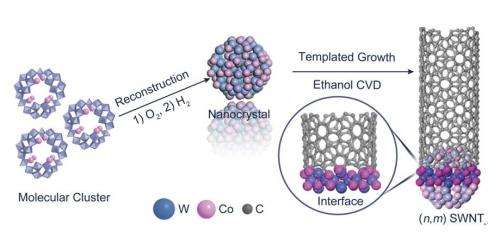Chirality-controlled growth of single-walled carbon nanotubes

Recently, Professor Li Yan's research team developed a novel strategy to produce single-walled carbon nanotubes with specific chirality by applying a new family of catalysts, which has great applications and influence in nanoelectornics and related fields.
"We need to use structure specific carbon nanotubes for real applications.The structure controlled growth has been a dream of our field for about 20 years. Recent work by Professor Yan Li at Peking University shows that it is finally realized. I believe her idea to use W-based catalyst is the landmark of growth of carbon nanotubes. We expect a plenty of very useful applications of carbon nanotubes based on her new discovery," said Professor Shigeo Maruyama from The University of Tokyo, who also serves the president of Fullerene, Carbon Nanotubes, and Graphene Research Society of Japan.
Single-walled carbon nanotube (SWNT), which can be considered as a seamlesscylinder formed by rolling a piece of graphene, may be either metallic or semiconducting depending on the manner of rolling denoted as (n,m) (or the 'chirality'). Relying on the fantastic structure and property, especially the extremely high mobility for both electrons and holes, SWNTs has shown great potential in various fields such as nanoelectronics.
In 2009, the International Technology Roadmap for Semiconductors (ITRS) selected carbon-based nanoelectronics to include carbon nanotubes and graphene for additional resources and detailed road mapping for ITRS as promising technologies targeting commercial demonstration in the next 10-15 year horizon.
However, it has been a big challenge for over 20 years to realize the chirality-selective synthesis of SWNTs. As stated by Dr. Avouris in his review article published in Nature Nanotechnology (V.2 P.605), "the main hurdle (of carbon-based electronics) is our current inability to produce large amounts of identical nanostructures…there is no reliable way to directly produce a single CNT type such as will be needed in a large integrated system." Inspiringly, Professor Li and her collaborators have made a breakthrough on this issue.
The catalysts, tungsten-based bimetallic alloy nanoparticles of non-cubic symmetry, have high melting points and consequently are able to maintain their crystal structure during the chemical vapor deposition (CVD) process, to regulate the chirality of the grown SWNTs. The (12,6) SWNTs are directly synthesized at an abundance of > 92% by using W6Co7 catalysts.
Experimental evidence and theoretical simulation reveal that the good structural match between the carbon atom arrangement around the nanotube circumference and the arrangement of the atoms in one of the planes of the nanocrystal catalyst facilitates the (n,m) preferential growth of SWNTs. This method is also valid for other tungsten-based alloy nanocatalysts to grow SWNTs of various designed chirality. "Employing tungsten-based alloy nanocrystals with unique structure as catalysts paves a way for the ultimate chirality control in SWNT growth. This may accumulate the development in SWNT applications, for example, carbon-based nanoelectronics", said Li.
The work was highly evaluated by Professor Jie Liu at Duke University, "The chirality-specific growth of single-walled carbon nanotubes is the most challenging and important issue in the field, which has not been solved for many years. Prof. Yan Li at Peking University first shows that the controlled growth is possible. This development is very important for the applications of carbon nanotubes in many fields, especially nanoelectronics."
More information: "Chirality-specific growth of single-walled carbon nanotubes on solid alloy catalysts." Feng Yang, et al. Nature 510, 522–524 (26 June 2014) DOI: 10.1038/nature13434. Received 28 February 2013 Accepted 17 April 2014 Published online 25 June 2014
Journal information: Nature Nanotechnology , Nature
Provided by Peking University





















